The Estonian Song and Dance Celebration 2025 review - the mass expression of freedom | reviews, news & interviews
The Estonian Song and Dance Celebration 2025 review - the mass expression of freedom
The Estonian Song and Dance Celebration 2025 review - the mass expression of freedom
Communion, ecstasy, rain and traditional clothing
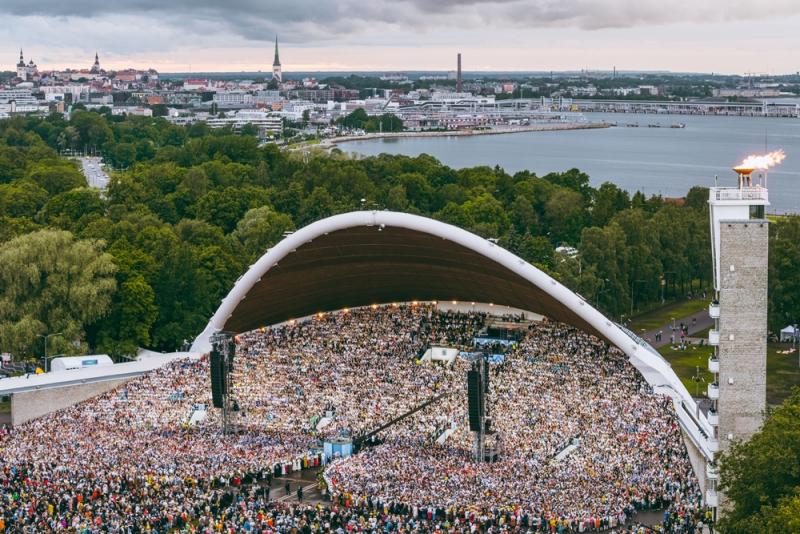
The branch of the fast-food chain Hesburger in downtown Tallinn shopping centre Solaris is busy. Nothing unusual as it’s located by the entrance to a multi-screen cinema. Double cheeseburgers and fries are going over the counter. Less typically, two-thirds of the people here are wearing traditional Estonian clothing. Men and boys with knee britches. Woman and girls in embroidered outfits with hats.
It’s a fair bet that, after eating, all of them will head east to the Estonian capital’s Song Festival Grounds (the Lauluväljak). They might be members of the audience, or singing on the 15,000-capacity stage.
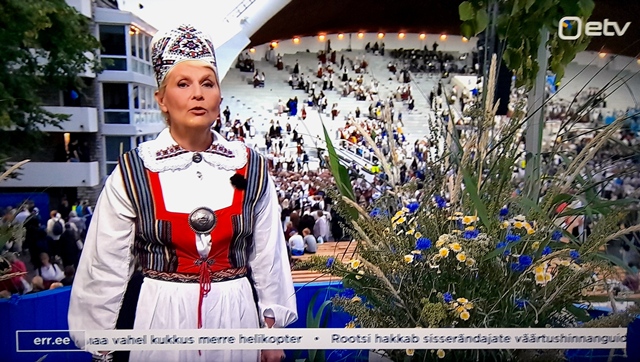 On the city’s streets, it’s the same. Everywhere, a significant proportion of folk are sporting outfits which could – at any other time – seem eyebrow-raising. Unusual. Eccentric even. However, during the Estonian Song and Dance Celebration, being at one with the nation’s identity matters. There’s nothing ironic or nationalistic in this. It comes across as natural. Turn on the television news and the presenter – with the Song Festival Grounds as a backdrop – is dressed appropriately (pictured right).
On the city’s streets, it’s the same. Everywhere, a significant proportion of folk are sporting outfits which could – at any other time – seem eyebrow-raising. Unusual. Eccentric even. However, during the Estonian Song and Dance Celebration, being at one with the nation’s identity matters. There’s nothing ironic or nationalistic in this. It comes across as natural. Turn on the television news and the presenter – with the Song Festival Grounds as a backdrop – is dressed appropriately (pictured right).
Under normal circumstances, the Song and Dance Celebration takes place every five years. The Covid pandemic messed this up, and 2025 is the first since 2019.
It goes on over four days: Thursday to Sunday. There are outliers in the immediate lead-up to the front end, when rehearsals at the Song Festival Grounds can be attended. The run-up itself commenced close-to a month earlier when, on 15 June, the Festival Flame began its journey through every county in the country. In the south, it commenced in Tartu County where there were seven stops. Every part of Estonia is reached, even the islands off the coast. It arrives in Tallinn by boat from Tilgu harbour, west of the city. Once at the Song Festival Grounds, the flame is taken up the stage-side tower where it is used to light a cauldron. The Song and Dance Celebration has its own lighthouse.
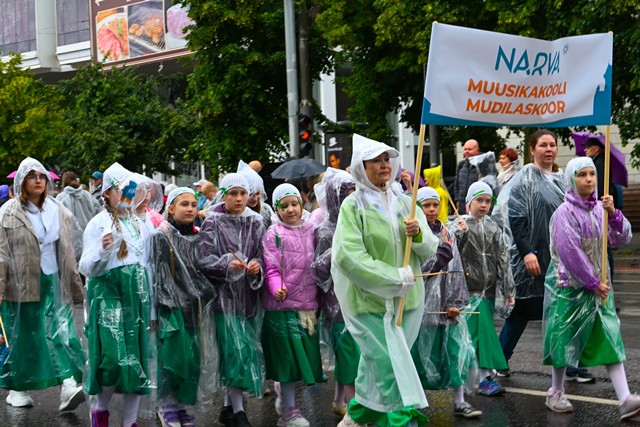 This could be compulsory. An occasion where buying in is obligatory. But no one looks press ganged. Despite the organisation and scheduling necessary, this is organic. People in Estonia want to celebrate, be part of this communion.
This could be compulsory. An occasion where buying in is obligatory. But no one looks press ganged. Despite the organisation and scheduling necessary, this is organic. People in Estonia want to celebrate, be part of this communion.
On the Saturday, when it never stops raining, there’s a procession from the city’s Freedom Square (Vabaduse väljak) to the Song Festival Grounds. All those taking part are making their way to the celebration. Each group has a banner or flag indicating where they are from. The differences in dress from region to region, from county to county, from town to town, and from village to village can be seen. One group is from Narva, Estonia’s eastern-most city – a border point with the Russian Federation (pictured above left, photo by Eliiss Juust). This is the first Song and Dance Celebration to follow the invasion of Ukraine.
The theme this year is “Kinship” – “Iseoma.” How, as the event’s programme puts it, “we’re all different, but together – those taking part in the Song and Dance Celebration and those attending them – we form a very special whole.” A concept distilled to “differences united.”
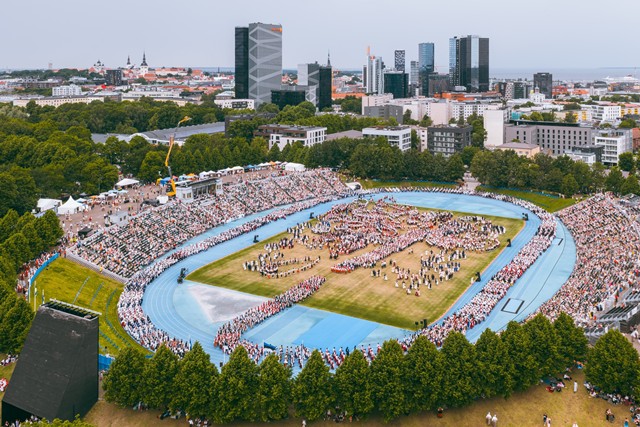 Back on the pavement, watching the procession, it swiftly becomes clear that while it is worth stating aspirations, what’s in the air – beyond the rain, that is – rams it home harder than any written words. There’s a palpable though invisible emotion. Standing on Pärnu Mnt., by the Estonian Drama Theatre, the feeling engulfs. An odd sensation, akin to ecstasy. Only a brick could be unaffected.
Back on the pavement, watching the procession, it swiftly becomes clear that while it is worth stating aspirations, what’s in the air – beyond the rain, that is – rams it home harder than any written words. There’s a palpable though invisible emotion. Standing on Pärnu Mnt., by the Estonian Drama Theatre, the feeling engulfs. An odd sensation, akin to ecstasy. Only a brick could be unaffected.
Some particulars. The stage at the enormous Song Festival Grounds is designed to hold 15,000 people. On the Saturday, the audience is 40,000. On the Sunday, it’s 58,000. There are 32,022 singers – not all on stage at once – at the Song Celebration (Laulupidu). The Dance Celebration (Tantsupidu) is held at the Kalev Stadium (pictured above right, photo by Kaupo Kalda). It brings together 10,938 dancers. There are three performances on Thursday and Friday, with 36 individual dances before an audience of around 15,000 each time. There is also, on the Friday afternoon, the Folk Song Celebration (Rahvamuusikapidu) in Freedom Square, at which 765 musicians play during seven presentations dedicated to each instrument (massed fiddles, kannels, bagpipes and so on) and an eighth, multi-instrument performance.
Some history. This is the 28th Song Celebration and the 21st Dance Celebration: the XXVIII Laulu-Ja XXI Tantsupidu. The first Song Celebration took place in 1869. A first dance celebration, as part of the Estonian Games, Dance and Gymnastics festival, was held in 1934. There have been interruptions – the level of logistics meant the early festivals could not be regular, the 20th century's world wars, serial occupations of Estonia interspersed with independence, and the final restoration of independence in 1991. Singing was integral to the movement towards independence, and the Song Festival Grounds a centre of expressing national identity (being here helps to understand Estonia’s Singing Revolution).
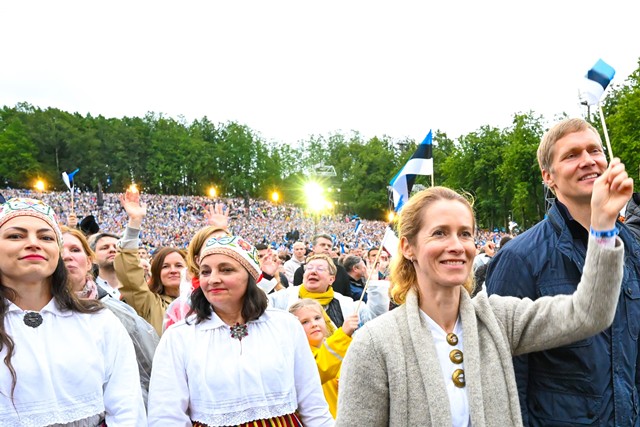 A snapshot. On the Sunday, with a stage complement of 15,000, an audience of 58,000 and perhaps two, three thousand more people here: those working on food concessions, maintenance, security, folk from radio and television, and so on – the total at the grounds is maybe between 75,000 and 80,000. Around a 16th of Estonia’s population is in one place, at one time. This includes Estonian President Alar Karis and former prime minister Kaja Kallas, who is now the EU High Representative for Foreign Affairs and Security Policy and Vice-President of the European Commission (pictured left with flag, photo by Aihivar Pihelgas).
A snapshot. On the Sunday, with a stage complement of 15,000, an audience of 58,000 and perhaps two, three thousand more people here: those working on food concessions, maintenance, security, folk from radio and television, and so on – the total at the grounds is maybe between 75,000 and 80,000. Around a 16th of Estonia’s population is in one place, at one time. This includes Estonian President Alar Karis and former prime minister Kaja Kallas, who is now the EU High Representative for Foreign Affairs and Security Policy and Vice-President of the European Commission (pictured left with flag, photo by Aihivar Pihelgas).
Along with those held in Latvia and Lithuania, the Estonian Song and Dance Celebration was, in 2003, included in the UNESCO Representative List of the Intangible Cultural Heritage of Humanity. The associated blurb says “both a repository and a showcase for the region’s tradition of performing folk art, this cultural expression culminates in large-scale festivals” and that “choirs and musical ensembles first became institutionalized in Estonia during the eighteenth century. Subsequently, choir singing spread throughout rural and urban areas, spurred by the growing popularity of choral music, singing societies and song festivals in Western Europe.” In this reading – relevant and spot-on as it obviously is – the celebration comes across as the revitalisation of something which is otherwise fossilised: like a concert of medieval music employing period-appropriate instruments or a reunited punk band grappling with how it was in 1977. Again, written words don’t quite capture it. This is confirmed at the Dance Celebration.
At the Kalev Stadium for the Dance Celebration, the music played back to accompany the dances is not limited to the traditional or what can be classified as folk as such. Contemporary electronica-folk-experimentalist Maarja Nuut is heard while “Miia mäng” (“Miia’s Game”) is interpreted through dance. Metal band Metsatöll are in the programme. As are Duo Ruut, whose second album has just come out. Popsters Ott Lepland, Tanel Padar and Jalmar Vabarna are also heard. Nonetheless, whatever the contemporaneousness of the music, the choreography reflects the landscape, its features, the seasons, Estonian life and traditions. The hiiu kandled (the talharpa, a bowed lyre) duo Puuluup soundtrack “Lambapesu mäng” (“Sheep-washing Game”).
 It is the seamlessness, sinuousness and execution of these ever-moving dances which dazzles most of all. The opening dance, “Tulemise tunne” (“The Feeling of Arrival”) (pictured right, photo by Sven Zacek), conjures visions of fractals or the division of cells. Two-and-a-half hours of this is a mind blower.
It is the seamlessness, sinuousness and execution of these ever-moving dances which dazzles most of all. The opening dance, “Tulemise tunne” (“The Feeling of Arrival”) (pictured right, photo by Sven Zacek), conjures visions of fractals or the division of cells. Two-and-a-half hours of this is a mind blower.
Afterwards, in Freedom Square at the Folk Song Celebration, experiencing 38 bagpipe players playing “Tori torud” (“Tori Pipes”) is another mind blower (pictured below left, photo by Tina Tuul). The tune is an arrangement of a 1936 recording of a fiddle, made in west Estonia. Another example of the malleability central to the Song and Dance Celebration; traditional or folk music is ever changing and can be brought into different contexts. In this spirit, here – this time in person – are Puuluup with 28 other talharpa players, singing and performing their own lively song “Heinakõrs” (“The Haystalk”).
Out at the Song Festival Grounds, things are necessarily less fluid and less spur-of-the-moment than at either the Dance Celebration or the Folk Song Celebration. The former as performances on this scale by choirs need to be static, and the latter due to the sheer magnitude of the event. There is barely any room for divergence when this amount of voices is gathered to sing together, and to perform so lengthy a programme. However, the unplanned happens – towards the end of Sunday, Mari Kalkun’s song “Elukoor” (“Choir of Life”) is received so enthusiastically by the crowd that it is performed twice, a spontaneous encore within the programme which proves to be a unique occurrence. The evening and the festival might end with traditional closer “Mu isamma on minu arm” (“The Land of my Fathers, the Land I Love”) but right here, right now this is the anthem the audience has chosen.
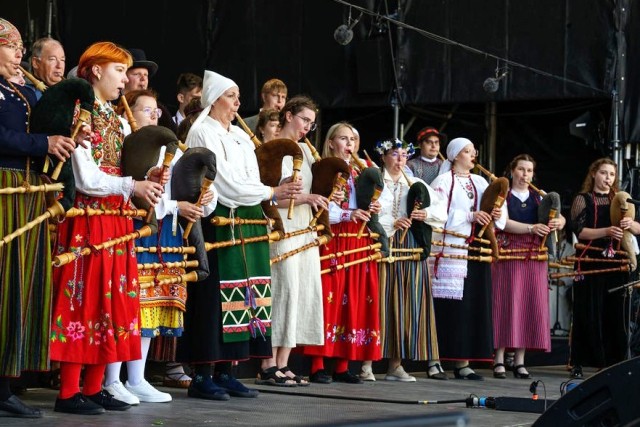 The programming of the Song Celebration on the Saturday night and Sunday afternoon and evening is exceptionally finely tuned. There is the accepted finale “Mu isamma on minu arm,” which has to be included. There is also the choice of songs which reflect all of Estonia’s regions. The programme has information and a map for each song, with a brief history of what's performed and an illustration showing the geographic origin. Choirs from throughout the country – and elsewhere: there is an Estonian diaspora in Australia and Canada as well as other places; there are even Brits on the stage – have applied to take part and not everyone can be chosen. Yet it looks as if all of Estonia and its musical traditions – Arvo Pärt, to cheers in what’s his 90th year, crops up – are represented.
The programming of the Song Celebration on the Saturday night and Sunday afternoon and evening is exceptionally finely tuned. There is the accepted finale “Mu isamma on minu arm,” which has to be included. There is also the choice of songs which reflect all of Estonia’s regions. The programme has information and a map for each song, with a brief history of what's performed and an illustration showing the geographic origin. Choirs from throughout the country – and elsewhere: there is an Estonian diaspora in Australia and Canada as well as other places; there are even Brits on the stage – have applied to take part and not everyone can be chosen. Yet it looks as if all of Estonia and its musical traditions – Arvo Pärt, to cheers in what’s his 90th year, crops up – are represented.
As a result, being present at the Song Festival Grounds is analogous to being invited into a space which is open to anyone yet hasn’t sprung to mind as accessible. Despite the enormity, it feels secret. Here you are, this is the take on the country’s identity and you are welcome to savour it, see how it lands. Visitors are welcomed.
For Estonians though, the chosen theme of kinship seems to understate it. United in song, united in dance, united musically, united as players and united as an audience, what’s being expressed is an accord, one which has withstood the occupations and thrives in independence. The music survived and so, it is being confirmed, will Estonia.
The future of Arts Journalism
You can stop theartsdesk.com closing!
We urgently need financing to survive. Our fundraising drive has thus far raised £49,000 but we need to reach £100,000 or we will be forced to close. Please contribute here: https://gofund.me/c3f6033d
And if you can forward this information to anyone who might assist, we’d be grateful.

Subscribe to theartsdesk.com
Thank you for continuing to read our work on theartsdesk.com. For unlimited access to every article in its entirety, including our archive of more than 15,000 pieces, we're asking for £5 per month or £40 per year. We feel it's a very good deal, and hope you do too.
To take a subscription now simply click here.
And if you're looking for that extra gift for a friend or family member, why not treat them to a theartsdesk.com gift subscription?
more New music
 Album: Josh Ritter - I Believe in You, My Honeydew
The alt-country singer's latest isn't consistent but does hit highs
Album: Josh Ritter - I Believe in You, My Honeydew
The alt-country singer's latest isn't consistent but does hit highs
 Album: David Byrne - Who is the Sky?
Born to be weird
Album: David Byrne - Who is the Sky?
Born to be weird
 Edinburgh Psych Fest 2025 review - eclectic and experimental
Underground gems and established acts in this multi-genre, multi-venue day long festival
Edinburgh Psych Fest 2025 review - eclectic and experimental
Underground gems and established acts in this multi-genre, multi-venue day long festival
 Album: Faithless - Champion Sound
Three decades into their career the perennial dance duo nail a lengthy but likeable set
Album: Faithless - Champion Sound
Three decades into their career the perennial dance duo nail a lengthy but likeable set
 Album: Saint Etienne - International
British pop institution’s final communiqué is an unalloyed winner
Album: Saint Etienne - International
British pop institution’s final communiqué is an unalloyed winner
 Album: Brad Mehldau - Ride into the Sun
A sincere tribute to Elliott Smith
Album: Brad Mehldau - Ride into the Sun
A sincere tribute to Elliott Smith
 Music Reissues Weekly: The Outer Limits - Just One More Chance
Exhaustive anthology unearths the full story of the Sixties mod-pop band from Leeds
Music Reissues Weekly: The Outer Limits - Just One More Chance
Exhaustive anthology unearths the full story of the Sixties mod-pop band from Leeds
 theartsdesk Radio Show 37 - Pete Lawrence of the Big Chill discusses the power of protest music and his new project This Is The Fire
Talking to cultural activist Pete Lawrence – camp outs, singalongs and saving the world
theartsdesk Radio Show 37 - Pete Lawrence of the Big Chill discusses the power of protest music and his new project This Is The Fire
Talking to cultural activist Pete Lawrence – camp outs, singalongs and saving the world
 Album: Sabrina Carpenter - Man's Best Friend
Short but not so sweet
Album: Sabrina Carpenter - Man's Best Friend
Short but not so sweet
 Album: CMAT - EURO-COUNTRY
The flame-headed chanteuse with the comic touch hits pop perfection
Album: CMAT - EURO-COUNTRY
The flame-headed chanteuse with the comic touch hits pop perfection
 Album: The Hives - The Hives Forever, Forever The Hives
No power ballads, no acoustic interludes - just speedy rock’n’roll all the way
Album: The Hives - The Hives Forever, Forever The Hives
No power ballads, no acoustic interludes - just speedy rock’n’roll all the way

Add comment